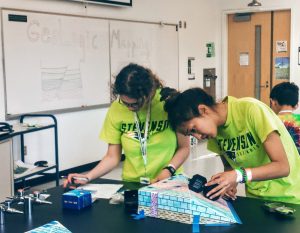Example Events
Past test, keys, and photos are available to download here.
Geologic Mapping

Science Olympiad’s earth science event focuses on the interpretation and understanding of geological features and processes from geologic and topographic maps. The event — referred to simply as “Geologic Mapping” in official Science Olympiad rules, competitions, and resources — will run for three competition seasons (2013-2016) as an event for 9th through 12th grade students. UTIG supports the event by writing several exams used around Texas, as well as the national rules which proctor the event.
Geologic Mapping test students on their ability to “demonstrate understanding in the construction and use of topographic maps, geologic maps, and cross sections, and their use in forming interpretations regarding subsurface structures and geohazard risks.”
In the event, students are asked to complete one or more hands-on or interpretive tasks selected from the following topics:
- i. plate tectonics, rock formation, Earth structure, Earth history, lithologies, and geological principles
- ii. major structural elements, fold geometries, fault types, intrusion types, and subsurface geometries
- iii. depositional and deformation sequences and erosional patterns
- iv. cross-section of topographic profiles, projections of mapped features, and stereonet projections
- v. bed thicknesses, orientation of planes from points, and map projection types
- vi. geohazard types, methods to assess, monitor, and mitigate the associated risk aquifers, underground fluids, and methods of exploration and production
Resources
Reading geologic maps:
USGS Education
Geologic Maps from USGS
Geology on About.com
Download geologic maps:
USGS Map Locator and Downloader
Map Projections:
USGS Universal Transverse Mercator Grid
USGS Map Projections
Geohazards:
USGS Geologic Hazards Science Center
University of Texas at Austin Regional 2015 Test Materials:
Texas A&M State 2015 Test Materials:
- State Test
- Test Materials part 1
- Test Materials part 2
- Test Materials part 3
- Test Materials part 4
- Answer Sheet
- Answer Key
University of Nebraska—Lincoln National 2015 Test Materials
Solar System
Science Olympiad’s planetary science event focuses on the observation and understanding of features and processes relating to extraterrestrial ice and water in the solar system. The event — referred to simply as “Solar System” in official Science Olympiad rules, competitions, and resources — ran for two competition seasons (2013-2015) as an event for 6th through 9th grade students. The event was sponsored by UTIG.
While the event is discontinued there is hope it will come back in the near future.
The Solar System event tests students on their ability to “demonstrate an understanding and knowledge of the properties and evolution of extraterrestrial ice and water in the solar system.” It focuses on specific targets that include, but are not limited to: Mars (polar ice caps, equatorial glaciers, permafrost), Europa (Thrace Macula, Thera Macula, Conamara Chaos, ridges, cycloids, plains, ocean, plumes), Enceladus (plumes, tiger stripes), Iapetus, Triton, Ceres, Titan, comets, the Kuiper Belt, and the Oort Cloud.
In the event, students are asked to complete one or more hands-on or interpretive tasks selected from the following topics:
- i. history and formation processes of specific features listed above
- ii. remote sensing, imagery, and satellite measurements of the features listed above
- iii. physical, thermal, and chemical properties of potential habitats for life
- iv. past, current, and planned future missions to explore these objects
- v. phase diagrams and different crystalline forms of water ice
Resources
National Exam:
Answer sheet
Answer Key
Exam questions
Image set 1
Image set 2
Image set 3
Image set 4
Image set 5
Image set 6
Example Questions:
Example questions 1
Example Tests:
Solar system guide 2 – Solar System Annotated Sample Test
Solar system test 1
Solar system test 2
Resource Presentations:
Surface features
Mars:
Mars Reconnaissance Rover
Mars Exploration Rovers
NASA JPL Mars Express
ESA Mars Express
PBS Habitability of Mars
Europa:
NASA Galileo Mission
JUICE – JUpiter ICy moons Explorer
Destination Europa
Life on Europa from Geology.com
Oceans in the Outer Solar System
PBS Habitability of Europa
ESA Cassini-Huygens
Enceladus:
NASA Jet Propulsion Lab Cassini Solstice Mission
Snows of Enceladus-Europlanet
Iapetus:
NASA Jet Propulsion Lab Cassini Solstice Mission
Ceres:
DAWN Mission – The Beginning of the Solar System
Titan:
NASA Jet Propulsion Lab Cassini Solstice Mission
Oceans in the Outer Solar System
PBS Habitability of Titan
Comets:
Evolution of Comets into Asteroids
Oort Cloud & Kuiper Belt:
NASA Kuiper Belt & Oort Cloud
General:
AAVSO Science Olympiad Site
NASA’s Solar System Exploration
Ice in the Solar System
Habitable Worlds Table
Habitable Zones-PBS
Extreme Life – California Academy of Sciences
CFA Webinars
